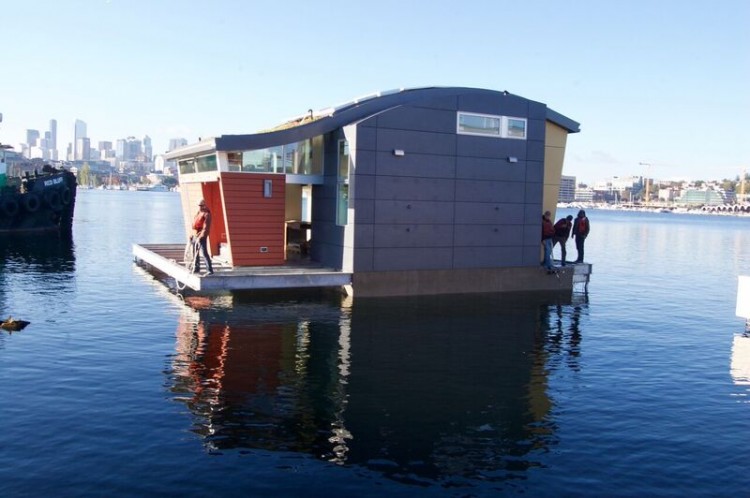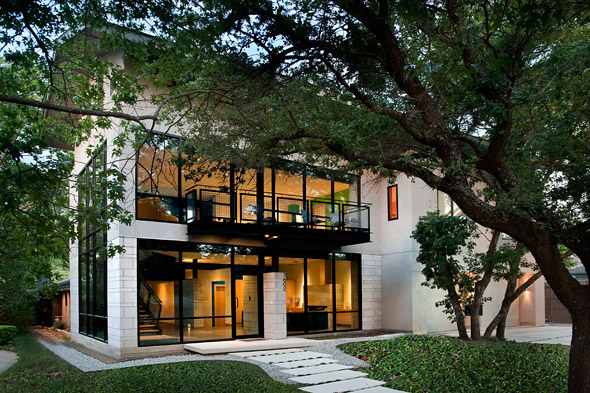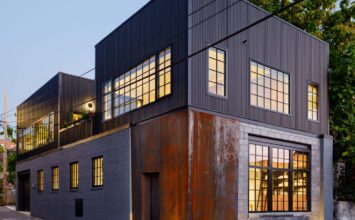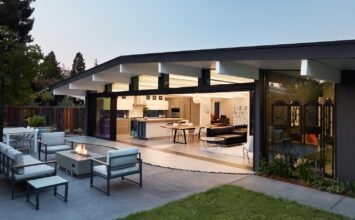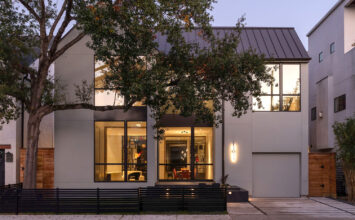
This Innovative, Eco-Conscious Floating Home Inspires Smarter Building Around Our Waterways
The upcoming Seattle Modern Home Tour will explore many takes on modern, including one home that is a living, breathing embodiment of unconventionally modern ways of living: a floating home on Lake Union. This innovative, eco-conscious home was conceptualized by homeowner Bill Bloxom around a fundamental question: What if we could improve shoreline with new structures instead of taking away from it?
With this eco-mandate in mind, Bill gathered a team – including his wife and architect, Michelle Lanker of Lanker Design LLC and Gloria Andrade of Andrade Design – to design a home that was both inspired and inspiring, showcasing the very design elements that would promote the preservation of shoreline habitat. Every detail of the 2025 sq. ft home was approached from a sustainable viewpoint, culminating in the home’s most important feature: in-water planters called “floating islands” that are suspended in the water below the home’s deck. Made from a recycled plastic matrix material, the floating islands are planted with native wetland species whose root systems grow through the planters and eventually extend to the water below, creating fish habitat. The concrete float of the home becomes an observation room for studying these floating islands through a large underwater window.
We caught up with architect Michelle Lanker to learn more about the floating home, building smarter around our waterways, and what to keep our eyes out for with this unconventional home.
Q&A w/ Michelle Lanker, Lanker Design LLC
This new floating home, which was built to replace a houseboat that burned down in 2007, was designed to be a catalyst for change. You and your husband, Bill Bloxom, wanted to explore how could improve the shoreline habitat instead of taking away from it. How did this come to be your mission?
Back in 2011 a friend who happened to also be a wetland and wildlife ecologist turned Bill on to the idea of incorporating artificial shoreline into the floating home project. Linda Krippner of Krippner Consulting had heard about these floating islands from a fish biologist who had told her how the technology was designed to improve water quality and potentially create new habitat for aquatic life. Bill and Linda got in contact with a company called Floating Islands West LLC in Mokelumne Hill, CA to learn more. Once they visited the Floating Islands West LLC facility and met one of the lead designers, Laddie Flock, Bill knew he had to put a team together to figure out how to incorporate this incredible technology into the floating home design. Exposing this technology to a wider audience and pushing the possibilities for how it could be applied became the primary reason for rebuilding the floating home.
In addition to innovation, we also wanted to make a statement about what life is about for us when living so close to nature. Bill had lived on the houseboat docks for many years prior to the rebuild of this floating home. There is a great history of advocacy and teamwork in this community. Taking care of the lakes and waterways we live on has always been one of the issues houseboat dwellers have cared about the most. Sometimes that means that older homes weren’t built with the best construction methods because the space humans were occupying was not as important of an investment. While passive eco-friendly design was incorporated through deep eaves for shade provided by roofs and single story spaces with many windows for ventilation, as these houses have aged and have needed upkeep many have still not embraced the technological side of environmental design. The lake is the most important feature of the home so footprints are as small as possible because more time is spent enjoying the lake than actually being in the house. The trend in new floating home design has not been moving in a direction of less impact though. New floating homes are becoming bigger as they are built to maximum heights and square footage limits, many times foregoing deck area entirely for a larger building footprint. The context of the natural environment is no longer a top priority. While these newer homes do not necessarily fit in aesthetically, they many times do take advantage of the energy efficient design technologies available today. We think our floating home is the best of both worlds. It respects the beauty of the lake aesthetically while incorporating the benefits of cutting edge technology. It maximizes its small footprint while still respecting the lake environment as it strives to be part of its eco system.

In what ways did this eco-mandate inform the design of the home? What sorts of environmentally-conscious design elements were incorporated?
When the form of the house was conceptualized, our designer, Gloria Andrade, strived to create an interlocking set of volumes that allowed for maximum multi-functional space and low profile to not disrupt views to the lake. A curved roof and sloped walls keeps view corridors as uninterrupted as possible for nearby neighbors as well as other docks. The second floor master suite pulls back from the entry creating a dramatic double height space that both serves as an aesthetic benefit as well as a stack space where hot air can rise to the second floor and escape through the operable windows and skylight located at the highest area of the house. This allows for passive cooling in the summer and eliminates the need for air conditioning. The purposeful wrapping of space creates shade and privacy for the window walls and punched openings throughout. There was no control over orientation since the dock slip was pre-existing, but as much as possible the south face has been taken advantage of for light and solar. Large window walls allow the south face both on the first floor and second floor to completely open up to the deck and master suite balcony to make the house feel much bigger than it actually is by taking advantage of outdoor living space.
During construction, the designer, contractor and I worked together to incorporate construction detailing to further contribute to the passive energy conservation qualities of the house. I am an architect who specializes in sustainable design and my husband and I wanted to pursue LEED certification for the home in order to create a healthy, resource-efficient, cost-effective building that enhances human lives while considering those of other species. Exterior walls and roof were designed with the maximum insulation thickness that the structure would allow which exceeds energy code requirements at R-38 for the walls and R-44.85 for the ceiling/roof. To ensure air leakage was minimized even further, polyiso spray foam insulation was used. Windows are triple glazed wherever possible to maximize the U-factor. A living roof has also been incorporated for 1/3 of the roof to add further insulation value to the interior of the house as well as contribute to minimizing heat island effect and for water conservation. Walls are constructed with a rain screen cladding system utilizing cement fiber panels for maximum durability and the other 2/3 of the roof is standing seam metal with a solar array attached to the ribs. For interior space, we selected finishes that would be both durable and easy to clean. This includes concrete floors in the basement and on the first floor and blackened steel panel flooring at the main entry. These floors are also heat sinks that remain warm during cold months and cool during hot months. Wherever possible, rapidly renewable and salvaged materials are used including bamboo flooring and cabinetry and original growth western cedar salvaged from the logs under the old houseboat for the curved ceiling at the roof and built-in furniture and custom doors throughout the house. We also have selected LED light fixtures, ENERGY STAR appliances, and low flow plumbing fixtures throughout. Finally, the heating system for the house is a geothermal heat pump system that takes heat from the water of the lake and uses it to heat the hot water for plumbing and the hot water that runs in the hydronic piping of the heated floors. The rest of the energy for the house is generated from the 5.32Kw solar array on the roof.

What were the greatest challenges that came with this project?
Due to the unconventional nature of the house and the unusual number of rules governing the project the greatest challenges were compliance with various interpretations of these rules and the waiting periods for approval. There were various agencies involved not only for the house construction, but also the removal of the old houseboat and transport of the new floating home from Port Townsend, where it was built, to Lake Union, where it’s currently moored.

You’ve said that you would like this home to serve as a “beacon of change.” In what ways can you see this floating home inspiring other homeowners and designers?
After our floating home was permitted, the building code in Seattle changed to no longer allow new basements to be used as any kind of functional space other than for floatation. There is concern underwater living space might add heat to the lake water or otherwise disrupt aquatic habitat. The concrete walls and floor are all insulated to keep any heat from escaping into the water and the floating islands have been incorporated to encourage the health and vitality of aquatic life. Floating islands have been proven to promote cleaner and better-oxygenated water at other installation locations. We need continued study to provide hard data on Lake Union at our floating home as well. If results show we are improving shoreline quality, this technology may be more even widely adopted. If all the houseboat decks and docks as well as commercial structures on the water were required to incorporate floating islands, how much more shoreline could we create? In the future, artificial shoreline requirements could be used to incent people who want a multi-functional basement in their floating home instead of making dead floatation space mandatory. We have also made the other sustainable design features stand out since we are located in a highly exposed area of the houseboat docks and the lake can be very busy. We want people to see our solar panels, and our living roof, and even plants growing from the floating islands. These may encourage others to want to learn more and consider their own ecological impact. We see our home as an education opportunity as much or more than as our own personal retreat.

What details of the home should tour-goers be sure to keep an eye out for?
Besides all the amazing eco-friendly design elements, tour-goers should be prepared for the wow factor when it comes to the elegance of how the interior spaces flow and feel so open and inviting. With very few interior walls, there are still a variety of space types from large gathering in the kitchen/dining/living space to private sanctuary in the upstairs master suite bathroom with its very special view to the lake. Tour-goers can also look forward to a completely unique experience of being underwater and seeing out to the lake from a window much larger than a tiny porthole. They may even get lucky and see a fish or two.
Purchase your tickets to the Seattle Modern Home Tour here!
